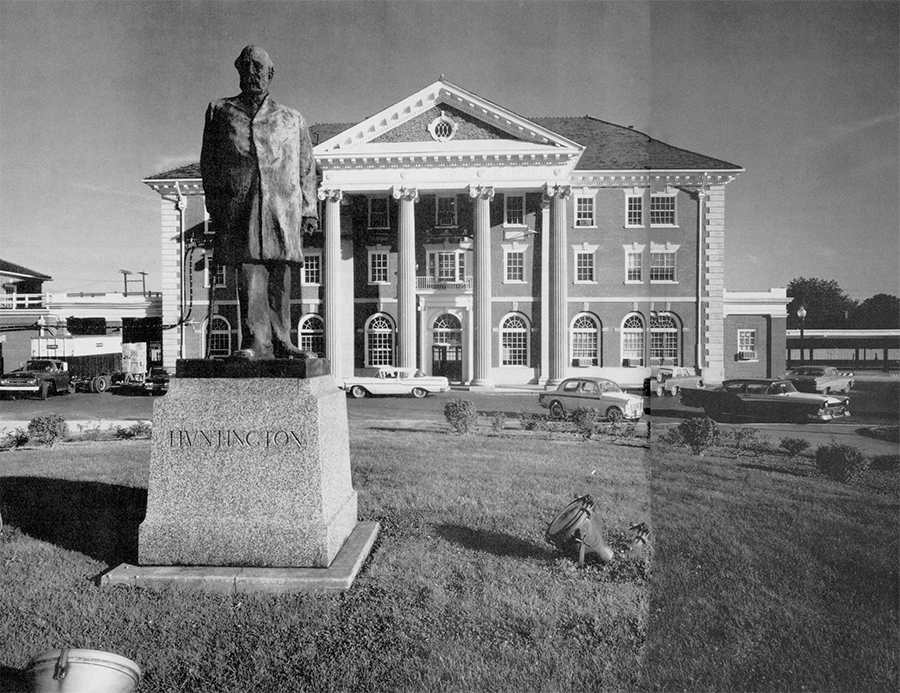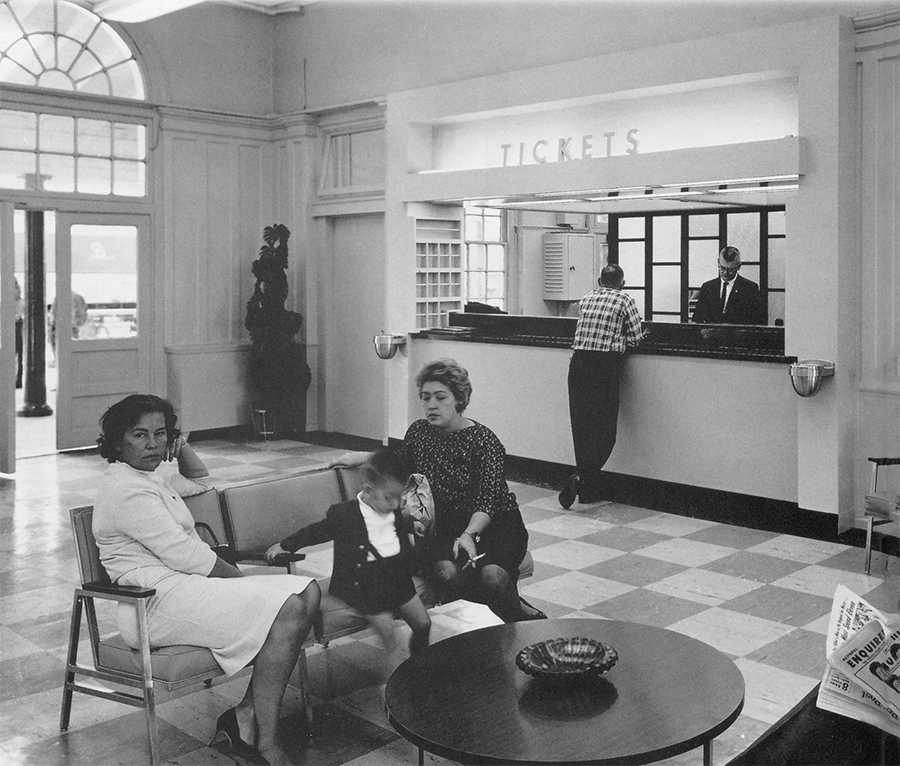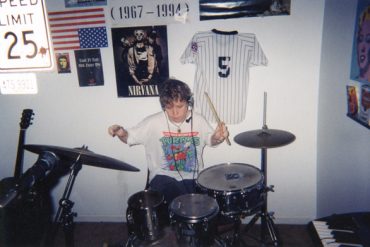The old C&O passenger station is a reminder of a romantic era when the roar of the train ruled the tracks
by Joseph Platania
HQ 26 | AUTUMN 1996
Few things seemed as exciting to a young boy on vacation back in the late 1940s and 50s than standing outdoors on a train platform and feeling the earth-shaking rumble and roar of a steam locomotive or diesel passenger train as those farflung machines of travel and adventure pulled into the station. The metallic din that produced clouds of slick-silvery steam from a parked locomotive was a reminder of the train’s implacable power. The railroad changed the skylines of cities with the construction of massive passenger train terminals in the heart of America. Many of these once imposing and bustling stations are now deserted and crumbling shells. Some have been converted to other uses. But Huntington’s architecturally significant C&O station has been well preserved and, in 1994, was renovated by its owner, CSX Transportation, at a cost of more than $3 million for continued use as a headquarters building for the C&O Business Unit.
At the time of its open house in May 1995, CSXT president and CEO A.R. “Pete” Carpenter said: “The railroad and Huntington have been inextricably linked since the C&O came to this community in 1873. We’ve grown up together, and we’re still changing and responding to the future.”
During the first 70 years of this century, the Fast Flying Virginian, Sportsman and George Washington were names with which local travelers became familiar. During this era, most TriState passengers boarded these palatial trains at the C&O station at 9th Street and 7th Avenue. But changes in transportation habits altered the face of the railroad. Now the Cardinal, an Amtrak passenger train, serves the area three days a week and a smaller terminal at 10th Street and 8th Avenue has replaced the former three-story station. However, the building remains a city landmark.
In the summer of 1913, the big news in town was the massive new C&O passenger station and office building being built on 7th Avenue between 9th and 10th streets. The Colonial Revival-style station was completed in late September and opened to the public.
Huntington’s station was by far the largest and most decorative of the Colonial Revival stations that the C&O would construct, and seemed appropriate in a city where the railroad had its repair shops, operating, mechanical and engineering headquarters, and was, in effect, its gateway to the Midwest. It replaced the earlier three-story brick and stone station that was built when the C&O first arrived in the early 1870s. The old depot was located on 8th Avenue and, when new, was completely isolated from the small community clustered near the Ohio River. However, by 1913 the new station was well within the built-up area of the growing city.
The January 1987 C&O Historical Magazine provides an architectural description of Huntington’s station. The magazine reports that the structure has many more of the Colonial/Classical Revival features than appear on the smaller buildings that the C&O built between 1905 and the early 1930s. It is three full stories high “with a fairly steep hipped roof,” according to the magazine. A cross gable on the street side develops into a portico supported by four Ionic columns. Two square Doric pilasters, or decorative piers that resemble columns, are attached to the brick. On the track side, the cross gable forms a dormer for a large two-story high Palladian window with a “decorative swag” that resembles a piece of draped cloth directly above it. A small wrought iron balcony that opened from the bottom of the Palladian window was located just above the roof of the train shed. In addition, a long train shed once extended on either side of the station covering a platform that could accommodate 15-car trains.
The article adds that a “port cochere, or large covered entrance porch through which vehicles can drive, adorned the west end of the building, one story high with doors for the waiting room that opened into it.” The article explains that this entrance was used to accommodate carriages and autos picking up and delivering patrons. Later the entrance porch was enclosed and converted to interior rooms.
The article adds that a two-story annex was built immediately to the east of the depot to accommodate additional offices.
In front of the station was a large plaza where in October 1924, the statue of railroad magnate, C&O builder and city founder Collis P. Huntington was unveiled.
An early 1930s photo shows a large metal “Welcome to Huntington” sign in the station’s front yard.
The area that was the station’s waiting room is now a “yardmaster management center,” states Tim Hensley, CSX resident vice-president for West Virginia. He adds that the room has yard masters for Richmond, Newport News, and Clifton Forge, Va., and for South Charleston and Huntington, W.Va.
Just west of the station, “two, three or four-car long tracks were installed for parking office pullman cars and other cars being set off at Huntington for occupancy,” states the magazine.

The magazine explains that the C&O is remembered for its Colonial style stations “because they were generally located in places that were given a high profile in the company’s passenger advertising and because colonial heritage was recurrent in the C&O’s Virginia roots and public relations efforts.”
The magazine notes that the first of the Colonial-style stations was built for Charlottesville, Va., in 1905, “and one of the last of these stations was built in 1930-31 at White Sulphur Springs, W.Va., and is probably the best known because of its location at the famous [Greenbrier] resort.”
On May 11, 1889, the first of the C&O luxury trains, the F.F.V., was introduced for a route between Washington, D.C., and Cincinnati. A local historian states that the name F.F.V. was derived from colonial times and referred to the aristocratic Virginia plantation owners who were known as “First Families of Virginia.” Later the initials were interpreted as “Fast Flying Virginian.”
In the early 1890s, the C&O operated a shuttle train making several trips daily between Huntington and Ashland, Ky. According to historical accounts, between the C&O and the Ohio River Railroad (later part of the B&O) 25 trains daily were arriving in Huntington by 1896.
During the closing years of the 19th century and the early years of the 20th, the C&O continued to extend tracks into valleys and hollows in the Tri-State to reach lucrative coal mines. Passenger trains often traveled to further destinations.
It was about this time that increased traffic prompted the need for a larger station in Huntington. In 1913, an “impressive three-story brick station was built behind the original building, fronting on 7th Avenue,” writes a local historian. He adds that the new depot had concrete platforms extending along the tracks from 8th to 10th streets, “protected by wooden ‘umbrella’ sheds so passengers could stay dry as they boarded a train in wet weather.”
William B. Newcomb’s first-hand knowledge of the C&O station goes back to the early years of this century. In a November 1983 Herald-Dispatch interview, Mr. Newcomb stated that Huntington’s “first station was built in 1873, but passengers did not use it until 1889.”
He explained that for the first 16 years, through trains used the 23rd Street “belt line” that transported passengers to what became the C&O’s freight station at 2nd Avenue and 9th Street. “The detour allowed passengers to transfer to and from ‘White Collar Line’ steamboats for Cincinnati,” Newcomb explained.
“The city wondered why the C&O had built that new station ‘way out there,’ and let it stay empty for so long, but when tracks were extended toward Cincinnati (in 1889), it turned out to be in just the right place.”
Newcomb remembered during one summer, when he was nine, a big thrill was visiting the new C&O terminal. “It is hard to describe the excitement that prevailed when the afternoon eastbound train pulled in at 5 o’clock,” he said. “Hundreds of people stood on the platform. Youngsters would speculate on every puff of smoke visible in the west, each hoping to be the first to see the locomotive round a distant curve.
“There would be warnings from station attendants to stand back and then a brief exposure to fire, steam; and swirling cinders as the engine thundered by. When the train came to a halt, families would spread out to spot some aunt or grandmother among the arrivals.
“Departing Pullman car passengers would seek out their car numbers and then stand chatting with friends while the train was worked over from end to end. The locomotive that had pulled the train from Cincinnati would be replaced with a fresh one from the roundhouse. The train would be cut in two to add cars and to rearrange the Pullman cars so they would be dropped off in proper order along the line.” Because of his work at the Anderson-Newcomb Co., Newcomb rode C&O trains to New York several times a year for 38 years.
In March 1930, the C&O inaugurated The Sportsman, a luxury train so named because it carried passengers to and from famous resort spots in West Virginia and Virginia such as The Greenbrier and The Homestead.
Less than two years later, the C&O introduced a new level of luxury passenger service with The George Washington, dubbed “the most wonderful train in the world.” It was inaugurated in April 1932 to commemorate the 200th anniversary of the birth of the first president. The train also emphasized the railroad’s link with George Washington who surveyed much of the country that lay along the railroad’s main line.
Advertised for long distance, air conditioned travel, The George Washington‘s rolling stock included sleeping cars, diner, library/lounge and observation cars.
According to a newspaper article, the Saturday before The George Washington‘s first trip, more than 1,800 people crowded the platform of Huntington’s station to visit the cars. Hundreds were at the station at 9:12 p.m. the following day when the eastbound luxury train rolled off on her maiden run filled to capacity.
During the 1930s, The George, as it was affectionately known, charged $8.20 for a coach ticket from Huntington to Washington. Nationwide, passenger boardings on trains soared as the Depression years faded into the war years with its massive mobilization.
A 1939 newspaper article reports that 25 passenger trains and 50 freight trains daily passed east and west through the C&O station.
A November 1983 newspaper article reports that during World War I, a canteen was housed in a small temporary building adjacent to the station’s platform. It opened on September 9, 1918, and was operated by the local Red Cross. The article explains that Mrs. Dan Mossman organized a volunteer force of 1,500 women to staff the canteen during the hours when troop trains were due. Food and money were donated daily by Tri-State merchants, labor unions and residents. Servicemen were often treated to “fruit and smokes” and then taken to local hotels or restaurants for hot meals.

Although there were military canteens across the country, Huntington gained the reputation as the best.
On May 23, 1995, CSX Transportation officials conducted an open house to show the results of an 11-month, $3.3 million renovation of the C&O Business Unit headquarters building, formerly the C&O passenger station. The interior of the 33,000 square-foot facility was redesigned for office space while the exterior was restored.
On the first floor are eight floor-to-ceiling Palladian windows with semi-circular fanlights that illuminate the building’s interior. The windows were made locally to match the original historic details. The building’s office space accommodates the approximately 100 CSX employees who work there.
The C&O Business Unit is a 1,900 mile section of CSXT territory that includes the principal routes of the former C&O Railway from Toledo, Ohio to Elkhorn City, Ky., and from Cincinnati to Newport News, Va., The unit serves 97 active coal mines.
The renovation also created the C&O Heritage Museum in a newly enclosed area that used to be a portico connecting the depot and the annex.
Stepping through the main entrance into the museum is like going back in time to an era when railroading was king. Inside, a large rack displays railroad timetables for the C&O, B&O, N&W and Virginian Railway.
Other highlights include a 12 foot by 16 foot photographic mural showing the lounge car of The George Washington.
Other museum attractions are:
A life-size mural of a 2700-series locomotive that was the workhorse of the C&O’s Huntington division during steam days.
A 60 inch by 83 inch mural representing the Fort Spring Tunnel located on the C&O between Ronceverte and Alderson, W.Va.
A display case exhibiting 12 kerosene lanterns with the appropriate color globes – red, blue, green, amber and clear – each color signifying a different meaning or action to be taken in railroad work.
A photographic history of the depot as a working passenger station including black-and-white photos of a ticket agent chatting with a young patron through his barred window, a waiting room newsstand, and a military canteen during World War II. There also is a photographic tribute to railroad workers.
Other railroad artifacts on display include switch keys, a semaphore signal and C&O china and silverware from The George Washington.
Other exhibits include one of Chessie and her family – the famous C&O symbol that enticed passengers to “sleep like a kitten” – and CSX’s world-renowned Greenbrier Resort at White Sulphur Springs.
Tim Hensley, who also is a railroad historian, was in charge of assembling the museum materials. He states that many of the artifacts came from his private collection as well as other private collections.
The museum is open to the public from 9 a.m. to 5 p.m., Monday through Sunday. Admission is free.





